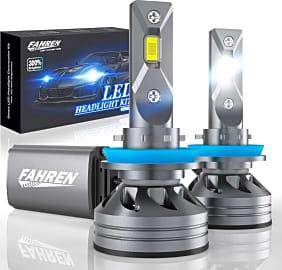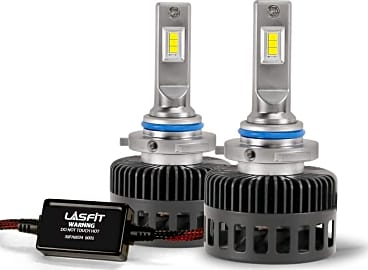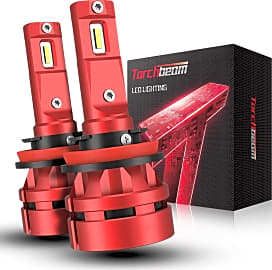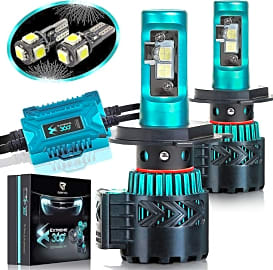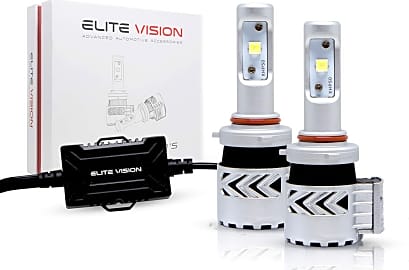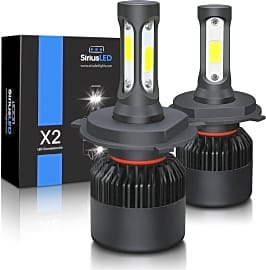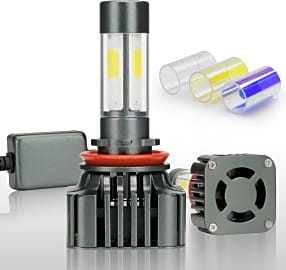The 10 Best LED Headlights

This wiki has been updated 39 times since it was first published in December of 2016. With a pair of these LED headlights installed in your car or truck, you'll be equipped to light the way forward in all driving conditions. They can replace stock bulbs or aftermarket halogen and xenon lights, and offer excellent brightness and color temperatures while consuming less energy than others. So whether you want improved safety, durability or aesthetics, there's something here for you. When users buy our independently chosen editorial picks, we may earn commissions to help fund the Wiki.
Editor's Notes
October 28, 2020:
Today’s update sees the addition of the top-selling Fahren H11/H9/H8, which project up to an impressive 10,000 lumens per set, making them three times brighter than many halogens. They’re easy to install in just a few minutes, are made of aviation-grade aluminum, and can run for up to 50,000 hours in total. They're CAN bus-ready for 98% of vehicles’ computer systems, although some models of Ford, Jeep, Dodge, and others might require an additional CAN bus decoder for installation. Today we also bring the Lasfit 9005 HB3 on board, which is a set that features a simple, compact design that does not incorporate any cumbersome external drivers. This means they can be plugged in to your vehicle’s housings easily. They’ll stay cool and run efficiently, thanks to their integrated temperature controls. They’ve got adjustable light angles, and you can purchase them with confidence, as they’re covered by a two-year warranty. This set replaces the Lasfit LS 9007, which is unavailable at this time.
For a flicker-free option designed not to cause radio interference, look to the newly added Torchbeam T2 H11, which also won’t produce dark spots or glare. This versatile choice can also be used as fog lights, and they won’t blind oncoming traffic. Note that the fans can be a bit noisier than some others, though. In today’s update, we also replaced an older model from Sealight with the Sealight Laxmas L2, which is an affordably priced selection with a 360-degree output radius, so you’ll have excellent visibility without dark spots or shadows. Many users praise this set for their pure white output. We also removed the JDM ASTAR 8th Generation and the OPT7 Flux Beam H11 due to availability issues.
August 30, 2019:
It's hard to argue against swapping out your vehicle's old halogen headlights for LEDs. Not only do they add a touch of flair, but LEDs are brighter, have a longer lifespan, and are generally more energy efficient.
However, this does not mean all LEDs are created equal. Budget models, like the SiriusLED X2 Xenon, will still shine pretty bright but are less durable, have lower quality LED chips and don't perform as well in high-beam mode as more expensive types.
In the upper price tier, models like the JDM ASTAR 8th Generation and the SNGL Super Bright Conversion Kit, are not only built with better parts but have special features such as anti-interference circuitry that minimizes radio static resulting from running LEDs.
Because heat buildup is considered to be the Achilles heel of LED headlights, we paid special attention to the quality and effectiveness of a model's cooling system. Broadly speaking, LED headlights tend to use either heat sinks, fans or both for thermal dissipation. One of the more recent innovations in the LED headlight world is the braided metal heat sink. This technology eliminates the need for the bulkier rigid heat sinks. The Putco Silver Lux have this newfangled heat sink and are a good choice for vehicles with small headlight housings.
We purposely excluded models that had over-complicated wiring and flimsy Molex connectors, as these are more prone to malfunctioning due to water exposure and generally not recommended.
Special Honors
XenonPro High Beams 9005 You can update your halogen headlights and fog lights to a premium set with this all-inclusive kit, which can increase the brightness and improve your visibility on the road. They’re assembled in the United States and Canada, and are calibrated to your make and model of vehicle. Their plug-and-play installation is extremely simple and quick, and they’re made of solid aluminum with a built-in micro-fan. They’re equipped with two waterproof drivers and are resistant to water and dust. You can choose a set that’s white, yellow, blue, or purple, in wattages of 25, 35, or 45. xenonpro.com
A Brief History Of LED Lights
In this phenomenon, light is made when an electrical current passes through a semiconductor.
While Thomas Edison gets all the credit for inventing the lightbulb, many people don't realize that he only created one type of bulb: the incandescent light. It was certainly a watershed moment in human history, but far from the only advance in artificial lighting made around that time.
After all, the LED light wasn't far behind.
Electroluminescence, which is the process through which LEDs emit light, was first discovered by British experimenter H.J. Round in 1907. In this phenomenon, light is made when an electrical current passes through a semiconductor. This allows for the creation of light with very little heat, enabling LED (or "light-emitting diode") lights to last longer, consume less energy, and be much smaller than their incandescent counterparts.
Still, commercial uses for LEDs were still a long ways off when Mr. Round made his discovery, especially considering that the light he discovered was outside of the visible spectrum. It wouldn't be until 1962 that an engineer for General Electric named Nick Holonyak, Jr., would create an LED that humans could see. Holonyak's little red lights would soon be found in calculators and watches the world over.
Within 10 years of Holonyak's invention, green and yellow lights would also hit the scene. Still, the red light was king, and as they replaced incandescent bulbs in electronics and computers, both the price and size of those items became much more consumer-friendly.
These lights would stay relatively dim until 1993, however, when Shuji Nakamura developed a new production method that created a much brighter beam. LEDs quickly became ubiquitous in flashlights as a result, and by the early years of the 21st century they'd taken over TVs as well.
In 2007, the Lexus LS600 hybrid became the first car to use LED headlights, and once other automakers saw the inherent advantages in these bulbs, many quickly followed suit.
It may have taken LEDs a few decades to catch up to their incandescent brethren, but as more and more industries turn to LEDs for their illumination, it's clear that their future is very bright indeed.
Benefits of LED Headlights
You might think that a headlight is a headlight, and as long as you can see well enough not to run over anything, you'll be fine. That may ultimately be true, but LEDs definitely offer a few major advantages over their halogen competition.
Now, don't expect miracles here, as this won't turn a Hummer into a Prius by any means, but every little bit helps.
First off, LEDs are extremely energy efficient. They won't put very much draw on your battery or alternator at all, which will in turn reduce your fuel consumption. Now, don't expect miracles here, as this won't turn a Hummer into a Prius by any means, but every little bit helps. They also last much longer, and you can probably expect your headlights to survive longer than your car if you switch to LEDs.
The light they put out is much crisper than that of traditional halogens, as well. This means that everything in your field of vision will be highly visible, allowing you to see and avoid any potential hazards that you might otherwise hit. However, many people find that halogens project their light farther down the road, giving them more time to react, so there may be a bit of a trade-off there.
Also, it should be noted that many LED lights are extremely bright for oncoming traffic. You can expect to get flashed often when driving at night, even with your low beams on.
Beyond that, however, LEDs just look really cool. They'll give your car a sleek, modern feel, and they emit a very clean, white light, which is something that oncoming motorists will appreciate right before they run off the road. Ultimately, if you want to feel like you're driving a car from the future, LEDs are definitely the way to go.
These lights won't change your life, and they may not be substantially safer than traditional halogens, but they'll give you a crispness you may never have seen before, while also saving you a few bucks on gas.
All in all, that's not a bad return for a simple set of lights.
What To Consider Before Making The Switch
If you're considering switching your car's halogen bulbs out for LEDs, there are a few questions you need to ask yourself before you whip out your credit card.
The most important thing to check is whether LEDs are even street legal where you live. After-market bulbs aren't kosher everywhere just yet, and even if you never get a ticket, installing them could prevent your car from passing inspection, or cause you to be at-fault in the case of an accident.
However, if you're only concerned with aesthetics or night-time visibility, it can certainly be worth making the switch.
The type of car you drive is another factor to consider. Some makes and models will require adapter kits, as well as heat sinks behind the diodes. The housing of your headlights can also affect their ability to project light, so that's something else you'll need to think about.
The lights may also cause conflicts with your vehicle's computer system. This can lead to erroneous warning messages, as well as flickering in the lights themselves. Check your owner's manual for any compatibility issues before installing after-market lamps.
Also, ask yourself why you want to make the switch. If it's to save money, chances are it won't be worth your while, as you'll have to spend some fairly serious cash on the lights, any extra gear necessary to install them, and installation costs if you're not comfortable doing it yourself. It's unlikely that you'll save enough in fuel or replacement bulbs to offset these expenses.
However, if you're only concerned with aesthetics or night-time visibility, it can certainly be worth making the switch. After all, nothing shows people that your '71 Pinto means business quite like a brand-new set of LED headlights.


